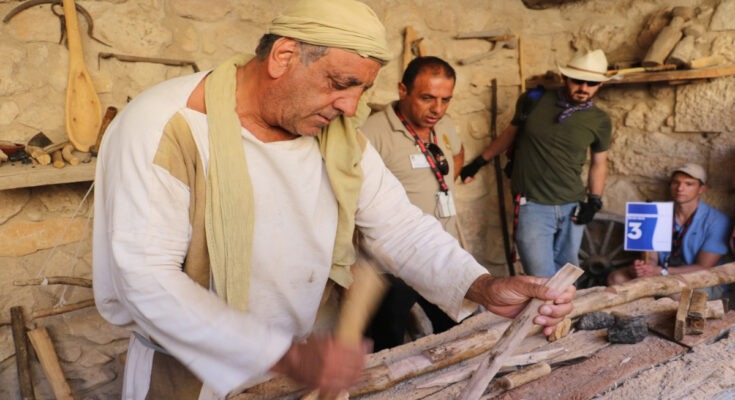The lives of the first Christian missionaries can be described with many words, but “boring” is not one of them. There were days of great excitement as men and women who had never heard of Jesus responded to the gospel. There were dangerous journeys over land and sea. Health risks and hunger were part of the daily routine. And there was open and hostile resistance to Christianity in many cities. Silas was one of the first missionaries, and he found out that serving Jesus Christ was certainly not boring!
Silas’s name appears in Acts at the end of the first church council on the Jewish/Gentile problem. The majority of early Christians were Jews who realized that Jesus was the fulfillment of God’s Old Testament promises to his people; however, the universal application of those promises had been overlooked. Thus, many felt that becoming Jewish was a prerequisite to becoming a Christian. The idea that God could accept a Gentile pagan was too incredible. But Gentiles began to accept Christ as Savior, and the transformation of their lives and the presence of God’s Spirit confirmed their conversions. Some Jews were still reluctant though and insisted these new Christians take on various Jewish customs. The issue came to a boiling point at the Jerusalem meeting but was peacefully resolved. Silas was one of the representatives from Jerusalem sent with Paul and Barnabas back to Antioch with an official letter of welcome and acceptance to the Gentile Christians. Having fulfilled this mission, Silas returned to Jerusalem. Within a short time, however, he was back in Antioch at Paul’s request to join him on his second missionary journey.
Paul, Silas, and Timothy began a far-ranging ministry that included some exciting adventures. Paul and Silas spent a night singing in a Philippian jail after being severely beaten. An earthquake, the loosing of their chains, and the resulting panic led to the conversion of the jailer. Later, they narrowly missed another beating in Thessalonica. Prevented by an evening escape. In Berea, there was more trouble, but Silas and Timothy stayed to teach the young believers while Paul traveled to Athens. The team was finally reunited in Corinth. In each place they visited, they left behind a small group of Christians.
Silas leaves the story as suddenly as he entered it. Peter mentions him as the co-author of First Peter, but we do not know when he joined Peter. He was an effective believer before leaving Jerusalem, and he doubtless continued to minister after his work with Paul was completed. He took advantage of opportunities to serve God and was not discouraged by the setbacks and opposition he met along the way. Silas, though not the most famous of the early missionaries, was certainly a hero worth imitating.
Strengths and Accomplishments
- A leader in the Jerusalem church
- Represented the church carrying the “acceptance letter” prepared by the Jerusalem council to the Gentile believers in Antioch
- Was closely associated with Paul from the second missionary journey on
- When in jail with Paul in Philippi, sang songs of praise to God
- Worked as a writing secretary for both Paul and Peter
Lessons From His Life
- Partnership is a significant part of effective ministry
- God never guarantees that his servants will not suffer
- Obedience to God will often mean giving up what makes us feel secure
Vital Statistics for Silas
- Where: Roman citizen living in Jerusalem
- Occupation: One of the first career missionaries
- Contemporaries: Paul, Timothy, Peter, Mark, Barnabas
Key Verses for Silas
“So we all agreed to choose some men and send them to you with our dear friends Barnabas and Paul – men who have risked their lives for the name of our Lord Jesus Christ. Therefore we are sending Judas and Silas to confirm by word of mouth what we are writing” (Acts 15:25-27).
Silas’s story is told in Acts 15:22 – 19:10. He is also mentioned in 2 Corinthians 1:19; 1 Thessalonians 1:1; 2 Thessalonians 1:1; 1 Peter 5:12.
Scripture Study Resources
ESV Study Bible – Study Bibles give you a deeper understanding of God’s Word with tools for life application like commentary, maps, charts, concordance, and study notes. Search our popular translations- NIV, ESV, NKJV, KJV and more!
Believer’s Bible Commentary: Second Edition – A Bible commentary is a written, systematic series of explanations and interpretations of Scripture. Commentaries often analyze or expound on individual books of the Bible, chapter by chapter and verse by verse. Some commentary works provide analysis of the whole of Scripture.
The New Strong’s Expanded Exhaustive Concordance of the Bible – The best concordance for word study! This exclusive new edition of a legendary classic puts generations of biblical research at your fingertips. A valuable tool for pastors, teachers, and students of the Bible.
Vine’s Complete Expository Dictionary of Old and New Testament Words – This classic word study resource allows you to study the meaning of biblical words in the original languages without spending years learning Greek or Hebrew. A great resource for students, seasoned pastors, and anyone who enjoys biblical word studies–even if they have little to no formal training in Hebrew or Greek.
Halley’s Bible Handbook – The beloved and classic Bible companion has been thoroughly updated, while retaining its time-honored features and Dr. Halley’s highly personal style, to offer even greater clarity, insight, and usefulness.




